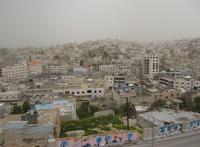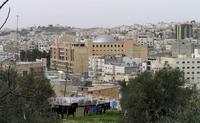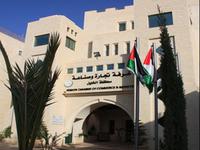You are in: Middle East -> Palestine -> Hebron/Al-Khalil Old... , and traditional search or Image Gallery will yield results of this site only
Hebron/Al-Khalil Old Town
| Site number: | 1565 |
|
| Type of site: | Cultural | |
| Date: | 13-16th centuries | |
| Date of Inscription: | 2017 | |
| Location: | Asia, Palestine, Hebron/Al-Khalil | |
Up to 75 images are shown here. Click on each for more details or on Image Gallery for more images.
| Description: | The use of a local limestone shaped the construction of the old town of Hebron / Al-Khalil during the Mamluk period between 1250 and 1517. The centre of interest of the town was the site of Al mosque -Ibrahim / the tomb of the Patriarchs whose buildings are in a compound built in the 1st century CE to protect the tombs of the patriarch Abraham / Ibrahim and his family. This place became a site of pilgrimage for the three monotheistic religions: Judaism, Christianity and Islam. The town was sited at the crossroads of trade routes for caravans travelling between southern Palestine, Sinai, Eastern Jordan, and the north of the Arabian Peninsula. Although the subsequent Ottoman Period (1517-1917) heralded an extension of the town to the surrounding areas and brought numerous architectural additions, particularly the raising of the roof level of houses to provide more upper stories, the overall Mamluk morphology of the town is seen to have persisted with its hierarchy of areas, quarters based on ethnic, religious or professional groupings, and houses with groups of rooms organized according to a tree-shaped system. --WHMNet's description is from WHC Site, where additional information is available.CC BY-SA 3.0. | |
| Hebron (Arabic: الْخَلِيل al-Khalīl; Hebrew: חֶבְרוֹן Ḥevron) is a Palestinian city located in the southern West Bank, 30 km (19 mi) south of Jerusalem. Nestled in the Judaean Mountains, it lies 930 meters (3,050 ft) above sea level. It is the largest city in the West Bank, and the second largest in the Palestinian territories after Gaza, and home to 215,452 Palestinians (2016), and between 500 and 850 Jewish settlers concentrated in and around the old quarter. The city is divided into two sectors: H1, controlled by the Palestinian Authority and H2, roughly 20% of the city, administered by Israel. All security arrangements and travel permits for local residents are coordinated between the Palestinian Authority and Israel via military administration of the West Bank (COGAT). The settlers are governed by their own municipal body, the Committee of the Jewish Community of Hebron. The city is venerated by Jews, Christians, and Muslims for its association with Abraham, containing the traditional burial site of the biblical Patriarchs and Matriarchs, within the Cave of the Patriarchs. In Judaism it is considered the second-holiest city after Jerusalem, while Islam regards it as one of the four holy cities. Hebron is a busy hub of West Bank trade, responsible for roughly a third of the area's gross domestic product, largely due to the sale of marble from quarries. It is locally well known for its grapes, figs, limestone, pottery workshops and glassblowing factories, and is the location of the major dairy product manufacturer, al-Junaidi. The old city of Hebron is characterized by narrow, winding streets, flat-roofed stone houses, and old bazaars. The city is home to Hebron University and the Palestine Polytechnic University. Hebron is attached to cities of ad-Dhahiriya, Dura, Yatta, the surrounding villages with no borders. Hebron Governorate is the largest Palestinian governorate with its population of 600,364 (2010). --Wikipedia. Text is available under the Creative Commons Attribution-ShareAlike License. CC BY-SA 3.0. |
||
| Source: | http://whc.unesco.org/en/list/1565. Description is available under license CC-BY-SA IGO 3.0 | |
| Source2: | Wikipedia (http://wikipedia.com). CC BY-SA 3.0. | |
| Reference: | 1. UNESCO World Heritage Center (http://whc.unesco.org/en/list/1565). 2. Wikipedia. CC BY-SA 3.0. | |












